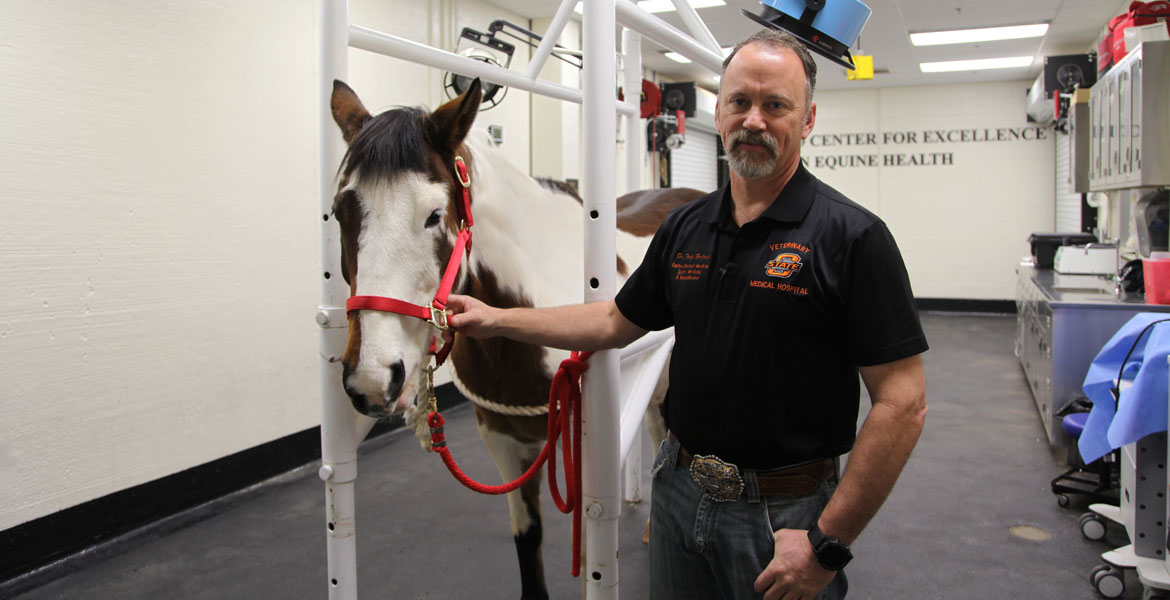
Blood Donors Save Bella
Thursday, May 24, 2018
Twenty-one days, 32 liters of blood, and a group of dedicated veterinary specialists – that’s what it took to save Bella, a 7 year old Appendix* Quarter Horse mare owned by Alexandra Wood of Broken Arrow, Okla.
Dr. Jenna Young, second year equine surgery resident, responded to an ambulatory call on Oct. 19, 2017. What she found was a lot of blood lost from a laceration underneath Bella’s tail.
“Her mucous membranes were pretty much white. Her heart rate was over 100; it was super high,” said Young. “She was very shocky and there was a vast amount of blood that she had lost. Her owner, Alexandra, was applying pressure with towels against the laceration. She was doing a great job and the bleeding had pretty much stopped.”
According to Alexandra, Bella had fallen.
“We looked around the barn but we couldn’t find anything that would have caused the laceration,” added Young.
They transported Bella to OSU’s Veterinary Medical Hospital for treatment.
“When Bella presented she was showing clinical signs of hemorrhagic shock,” explained Dr. Todd Holbrook, equine section chief and equine internal medicine veterinary specialist. “A normal heart rate in a horse should be 40 or so. Hers was over 100. We obtained a blood sample from Bella and a donor horse in the Hospital to cross-match them.”
As a referral source for veterinary medical specialty cases, OSU’s Center for Veterinary Health Sciences has two distinct advantages for patients requiring blood transfusions. One, there is a clinical pathology lab on site that can quickly cross-match blood samples from the patient and potential blood donors to make sure they are compatible. If the blood groups do not match, the horse receiving the blood could have a life-threatening reaction and will break down those red cells rapidly, thus the transfusion will be ineffective. Second, the OSU Center for Veterinary Health Sciences Ranch maintains a herd of five to 22 horses to act as blood donors.
“Within probably two hours, we had volumes of blood being transfused into Bella in an attempt, honestly, to save her life,” continued Holbrook. “Eventually we obtained blood from four different donors. You can only take so much blood from a horse when you’re performing a transfusion. We ended up collecting approximately 8 liters of blood from four different horses. In my 30 years of experience, that is the largest volume of blood that I have ever transfused to a horse. It was touch and go there for almost two days.”
In addition to many blood donors, one of the things that helped save Bella was the fact that the source of the bleed was located.
“Dr. Mike Schoonover, board certified equine surgeon, was able to actually get a clamp on the artery. The laceration was about mid-forearm distance in to the left side of her vulva,” stated Young. “He was able to feel which direction the blood was coming from and put a clamp on it.
“When Dr. Schoonover was palpating her to locate the source of her bleeding, he felt two sharp edges of bone in her pelvis,” added Young. “We think she likely sustained a pelvic fracture when she fell at the farm and that lacerated a major artery and caused the external wound as well.”
To avoid Bella hemorrhaging again, her team decided it was best to leave her where she was once the clamp was in place.
“She lived in the stocks basically for four days straight,” reported Young. “She was a very good mare.”
“And incredibly tolerant of everything we put her through,” added Dr. Amy Lovett, first year equine internal medicine resident. “We put mats under her feet for cushioning. We had hay and water set up in front of her. We had people with her 24/7 to make sure she didn’t get into any trouble.”
Finally, after a three-week stay, Bella went home.
“We’re unsure at this point if she’s going to be able to be ridden due to the pelvic fracture. However, she is very comfortable at a walk. So we are hopeful that she may be able to be ridden in the future and will at least be pasture sound,” concluded Young.
In March of 2018, Bella returned to the Hospital for a recheck. Alexandra’s father, Billy Wood, commented on Bella and his experience at OSU’s Veterinary Medical Hospital.
I don’t think she (Bella) knows anything ever happened,” said Wood. “She shouldn’t be here. I think they (Hospital clinicians) care more than I expected. They are very personable and explained everything. They’ve just been perfect. Really, I couldn’t ask for more.”
Bella has now returned to light work under the saddle. She is one of 1,200 to 1,500 equine cases a year treated at Oklahoma State University’s Veterinary Medical Hospital.
*An Appendix Quarter Horse is the result of breeding a Quarter Horse with a Thoroughbred.
